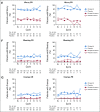Niraparib Maintenance Therapy in Patients With Recurrent Ovarian Cancer After a Partial Response to the Last Platinum-Based Chemotherapy in the ENGOT-OV16/NOVA Trial
- PMID: 31173551
- PMCID: PMC6839909
- DOI: 10.1200/JCO.18.02238
Niraparib Maintenance Therapy in Patients With Recurrent Ovarian Cancer After a Partial Response to the Last Platinum-Based Chemotherapy in the ENGOT-OV16/NOVA Trial
Abstract
Purpose: In the ENGOT-OV16/NOVA trial (ClinicalTrials.gov identifier: NCT01847274), maintenance therapy with niraparib, a poly(ADP-ribose) polymerase inhibitor, prolonged progression-free survival in patients with platinum-sensitive, recurrent ovarian cancer who had a response to their last platinum-based chemotherapy. The objective of the study was to assess the clinical benefit and patient-reported outcomes in patients who had a partial response (PR) and complete response (CR) to their last platinum-based therapy.
Patients and methods: A total of 553 patients were enrolled in the trial. Of 203 patients with a germline BRCA mutation (gBRCAmut), 99 had a PR and 104 had a CR to their last platinum-based therapy; of 350 patients without a confirmed gBRCAmut (non-gBRCAmut), 173 had a PR and 177 had a CR. Post hoc analyses were carried out to evaluate safety and the risk of progression in these patients according to gBRCAmut status and response to their last platinum-based therapy. Ovarian cancer-specific symptoms and quality of life were assessed using the Functional Assessment of Cancer Therapy-Ovarian Symptom Index.
Results: Progression-free survival was improved in patients treated with niraparib compared with placebo in both the gBRCAmut cohort (PR: hazard ratio [HR], 0.24; 95% CI, 0.131 to 0.441; P < .0001; CR: HR, 0.30; 95% CI, 0.160 to 0.546; P < .0001) and the non-gBRCAmut cohort (PR: HR, 0.35; 95% CI, 0.230 to 0.532; P < .0001; CR: HR, 0.58; 95% CI, 0.383 to 0.868; P = .0082). The incidence of any-grade and grade 3 or greater adverse events was manageable. No meaningful differences were observed between niraparib and placebo in PR and CR subgroups with respect to patient-reported outcomes.
Conclusion: Patients achieved clinical benefit from maintenance treatment with niraparib regardless of response to the last platinum-based therapy.
Figures




References
-
- Hanker LC, Loibl S, Burchardi N, et al. The impact of second to sixth line therapy on survival of relapsed ovarian cancer after primary taxane/platinum-based therapy. Ann Oncol. 2012;23:2605–2612. - PubMed
-
- Ledermann JA, Raja FA, Fotopoulou C, et al. Newly diagnosed and relapsed epithelial ovarian carcinoma: ESMO Clinical Practice Guidelines for diagnosis, treatment and follow-up. Ann Oncol. 2013;24:vi24–vi32. - PubMed
-
- Tapia G, Diaz-Padilla I. Molecular mechanisms of platinum resistance in ovarian cancer , in Diaz-Padilla I (ed): Ovarian Cancer: A Clinical and Translational Update. Rijeka, Croatia, InTechOpen, 2013, pp 205-223 .
-
- Ledermann JA, Sessa N, Colombo N, et al. http://www.esmo.org/Guidelines/Gynaecological-Cancers/Newly-Diagnosed-an... eUpdate: Ovarian cancer treatment recommendations.
-
- National Comprehensive Cancer Network https://www.nccn.org/professionals/physician_gls/pdf/ovarian.pdf Clinical practice guidelines in oncology: Ovarian cancer, version 2.2018.
Publication types
MeSH terms
Substances
Associated data
LinkOut - more resources
Full Text Sources
Other Literature Sources
Medical
Research Materials

